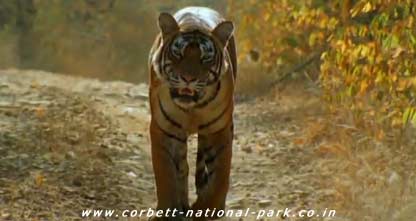|
have
Banj Oak growing, which is essentially
a Himalayan species.
Palms
include Date palm that grows in
open areas. Kanju (Holoptelia integrifolia),
Jamun (Syzygium cumini) and Aamla
(Emblica officinalis) are found
scattered moist areas. Other major
tree species are

Flowering trees lend colour to the
forests in Corbett. The main ones
are Kachnaar (Bauhinia variegata)
with pink to white flowers, Semal
(Bombax ceiba) with big red blooms,
Dhak or Flame-of-the-forest (Butea
monosperma) with bright orange flowers,
Madaar or Indian Coral (Erythrinia
indica) with scarlet red flowers
and Amaltas (Cassia fistula) with
bright yellow chandelier like blooms.
Some species of trees that do not
occur naturally in the Park have
been artificially planted in and
around habitation. These include
-
Teak
(Tectona grandis),
-
Eucalyptus,
-
Jacaranda
-
Silver
Oak
-
Bottlebrush
Grasses
Grasses
form the largest group of plant
species in Corbett with more than
70 species recorded. They occupy
different habitats, especially chaurs.
They include
They
include
Bamboo
In
some parts of Corbett the vegetation
is dominated by bamboo forest. The
main species is Male Bamboo having
clustered stout stems and shining
papery stem sheaths. Bamboos follow
a peculiar flowering process. All
bamboos in a forest, flower together
at the same time once in several
decades. After flowering, fruiting
and dispersal of seeds, all plants
die together.
Shrubs
Shrubs
dominate the forest floor. There
are several species of Ber found
in open areas that provide food
and habitat to many birds and animals.
Maror phali is an easily noticeable
shrub. Its fruits are in the form
of twisted spiralling pods. Karaunda
with pinkish-white flowers and sour
fruit is found under sal. Hisar
has yellow, juicy, berry-like fruits
that are savoured by animals. Jhau
is found along the Ramganga basin
on sandy or rocky soil.
|

